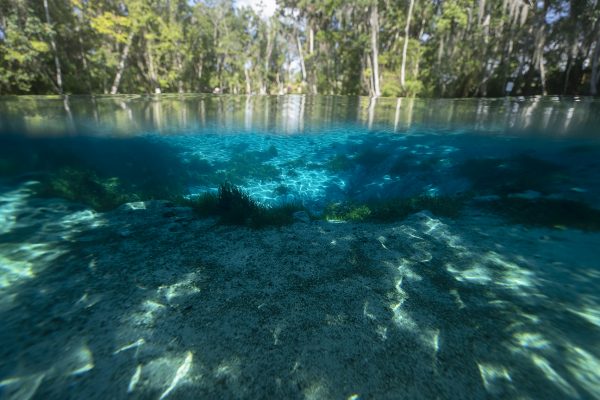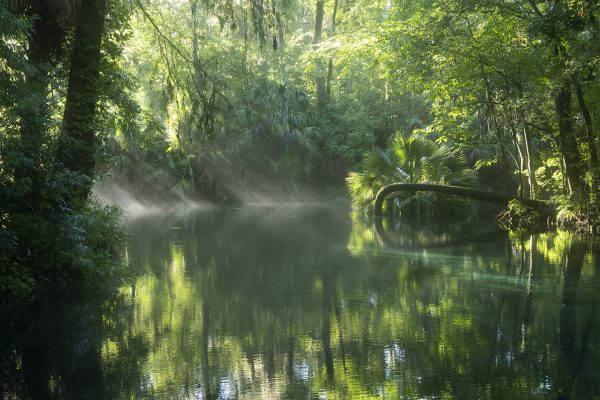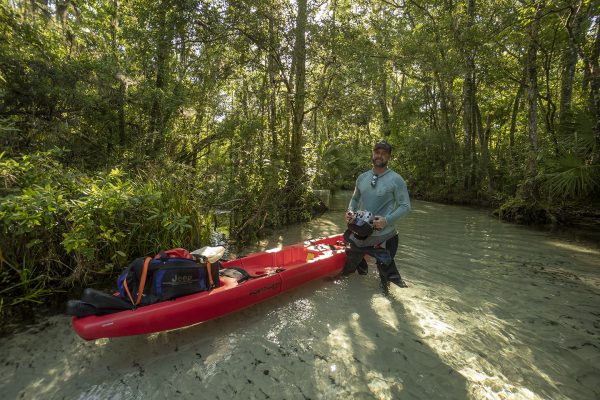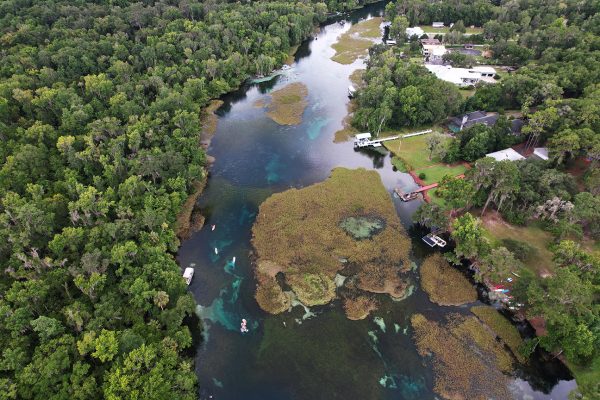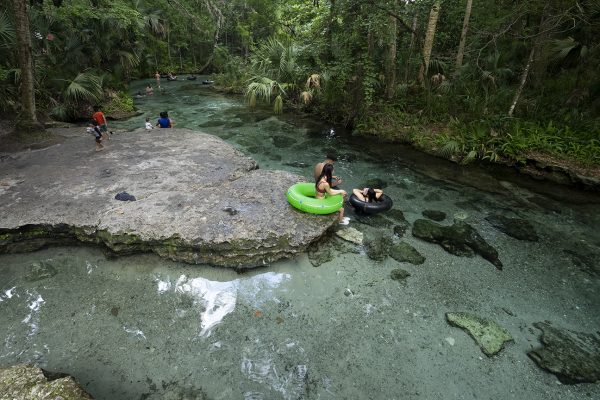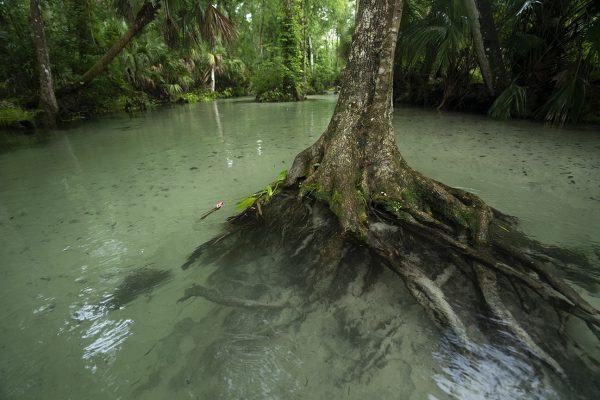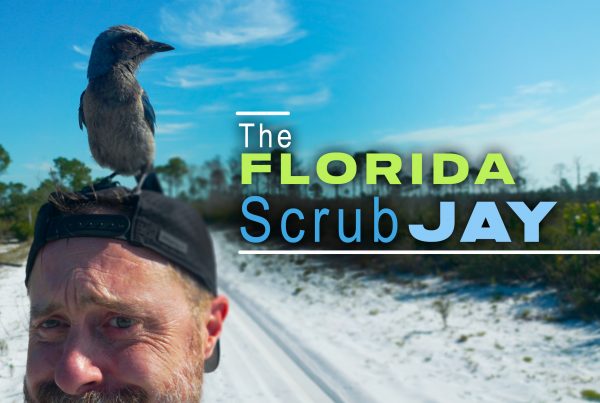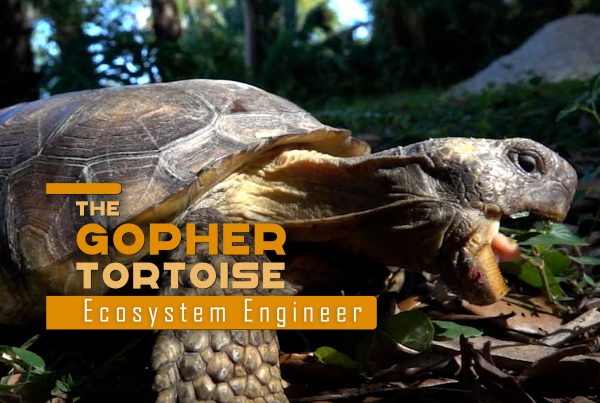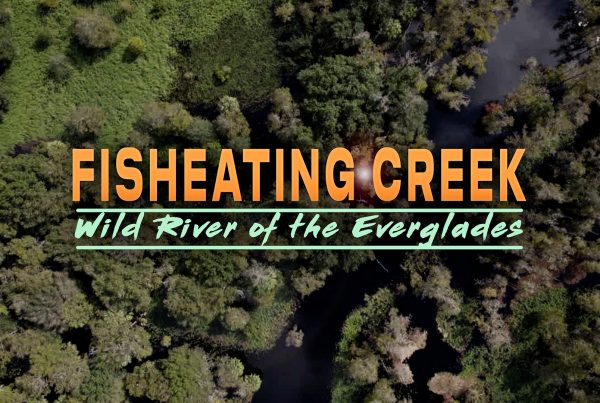Florida’s springs are magical habitats that are windows into the aquifer. They also support a diversity of life, including the lovable Florida manatee!
“The Siren and the Springs” takes audiences into the world of Florida’s incredible artesian springs systems. Over 1,000 springs gush forth their crystal-clear contents, creating magical landscapes and biodiverse habitats. The world’s largest concentration of artesian springs can be found here.
The Kern team explores the hydrogeology of our aquifers and springs. We’ll dive in, quite literally, to our source of naturally purified drinking water. Lush eelgrass beds, diving birds, turtles and of course, the universally loved Florida manatee are all important pieces of the ecological puzzle of Florida’s freshwater springs.
The Siren and the Springs
The Siren
Me – “Scout, alright. Scale of 1 to 10, how excited are you to swim with manatees?”
Scout, thinks for a second and then shyly: “I don’t know. Oh, dolphin!”
We only love what we know, and we only protect what we love. Simple, obvious, profound.
Don Markham – “So everyone comes here to Crystal River to swim with these manatees, they’re such a fun, lovable, peaceful, docile creature. They’re so ugly, that you gotta love them. Them big, huge snouts and the whiskers, um, they’re absolutely adorable.
If you’re one of the very few people that doesn’t agree, we need to have a serious conversation.
Dr. Buddy Powell – From a conservationist standpoint, it’s been a success story. We’ve seen, back in the day we estimated about 1,000 manatees in the State of Florida. But over the past 40 years, we’ve seen that population grow to 6, 7, 8 thousand perhaps depending on the estimate.
A success story indeed, thanks to education and a deeper understanding of this rare marine mammal. But the Florida manatee has had a difficult history. And now it faces new threats that are not only impacting the manatee, but entire aquatic ecosystems.
Buddy – Florida is a rapidly growing state. So what we are seeing, particularly in our coastal areas, whether we’re talking about manatees or other species, is our water quality is changing, and it’s changing for the worst.
We’ll get into all of that soon enough, but first, what, exactly is a manatee? Until recently, this docile mammal was mythologized and misunderstood.
Dr. Anmari Alvarez Aleman – Well there are 3 existing species of manatees. They all belong to the order Sirenia. And these three species are the Amazonian manatee, there is the West African manatee, or the African manatees, and there is the West Indian manatees, Tricheccus manatus.
Sirenians, often called “sea cows,” are aquatic mammals distantly related to elephants.
There are two sub-species of the West Indian manatee: The Florida manatee and the more widely distributed Antillean manatee.
Anmari – There are very good population estimates for Florida, the technique and analysis tools to estimate have improved significantly, but that is not the case for most of the Antillean population. We do have some estimates for Puerto Rico, which is around 300, 400 individuals,
How about some Florida manatee facts:
This species can grow to over 9 feet long and tip the scales at more than 1,000 pounds.
Manatees have some interesting adaptations for a life aquatic. Densely mineralized rib bones act as ballast, or weights, allowing the animals to sink to the bottom while resting or feeding. Also, they have elongated lungs and specially designed diaphragms. Think of these features as buoyancy control devices, like what scuba divers wear. Super handy for a marine mammal.
The only strong social bond is between the mother and her baby. If you listen closely, sometimes you can hear the calf’s chirping vocalizations. So cute.
Mothers typically only give birth to a single calf.
Jennifer Galbraith. – Manatee calves are dependent on their mothers for 2 years. And in that time they learn everything from their mothers: where to find food, where to find warm water, those migration routes, they nurse from them in that time, and it’s critical for manatees to have that exposure to be able to go out after they reach a sub adult age and be productive animals.
Calves nurse from nipples located near the mother’s armpits. Weird, but hey… it seems to work for them.
Manatees are herbivores. They can consume as much as 10% of their body weight in veggies each day, grazing and browsing for up to 8 hours.
Many of the waters they navigate can be quite turbid. Their beady little eyes aren’t very perceptive, but nerve endings in the follicles of the wiry hairs distributed all over their bodies allow them to feel their way around quite effectively.
Manatees have no natural predators, emphasis on “natural.” But they face many threats.
Buddy – So manatees were probably always hunted by the original peoples, in fact they have found evidence of manatee bones in middens and things like that, and then Europeans came and they were also hunting manatees. There were advertisements in New York, for example. “Come to Florida to hunt manatees.”
But then that hunting pressure was replaced by manatees being killed and harmed by watercraft.
Boat strikes are such a constant threat, in fact, that most manatees in Florida bear the scars. But it’s not the nasty gashes that are often fatal. It’s the impact. Their bones are hard, but brittle. Broken backs and ribs are the real killers.
And then there’s habitat loss due to human development and pollution.
Kimberly Dinkins – Manatees have no natural predators, but they rely on healthy seagrass meadows and shoreline vegetation for their nutritional needs.
But these food sources are disappearing.
Manatees are a tropical species and are very sensitive to cold weather. Although they look chunky, they’re surprisingly lean. They do not have a substantial, insulating layer of blubber like whales and seals, and cannot survive sustained temperatures below 68 degrees Fahrenheit. During the winter months, Florida’s ocean waters often dip into this dangerous territory. When this happens, manatees look for warmth, and they can find their temperate, crystalline refuges in Florida’s springs.
The Springs
Me – Brrrr. So when I woke up this morning, the air temperature was 47 degrees. But this water actually feels great, and that’s because this is artesian spring water from deep underground. Florida’s springs, that water is consistently somewhere around 72 or 74 degrees all year round. Now that can be life saving for manatees during the winter. When water temperatures dip below about 68 degrees, those temperatures can be potentially fatal. They can cause cold stress, hypothermia, and manatees need these warm water refuges to stay alive, essentially. And there’s no better place than Florida’s Springs.
Florida has over 1,000 artesian springs, each gushing their gin-clear contents to the surface. This is the largest concentration of artesian springs on the planet.
Flowing from deep underground, spring water is 72 degrees regardless of the season. This is the average air temperature in Florida, and although it can seem a bit chilly in July, it can be lifesaving for manatees in January.
Manatees conserve their energy during cold weather events: eating less, resting a lot. They’re simply trying to survive. While you may find a few in the springs during the summer, most are spread out along their coastal feeding grounds. But here in February, Blue Springs is the place to be for over 600 manatees. Can you blame them? The water is balmy, pure, and the setting is gorgeous.
Florida’s springs create rich habitats for manatees and a host of other aquatic life. They’re also windows into our precious source of naturally purified fresh water.
Dr. Jenny Adler – Even though groundwater is hidden beneath our feet here in Florida in the aquifer, it’s an essential part of our lives and I like to say we kind of spend our lives walking on water here in Florida because the water is just beneath our feet but we can’t see it, except for the places where it kind of comes to the surface at these springs.
An aquifer is an underground layer of water-bearing permeable rock, rock fractures or unconsolidated materials such as gravel, sand or silt. Think of it as a rocky sponge that holds groundwater. The great Floridan Aquifer underlies our entire state as well as parts of Georgia, South Carolina, and Alabama. This platform of limestone rock, deposited over 20 million years ago, is basically the sedimentary remnants of ancient coral reefs and marine creatures.
Limestone is soluble and rainwater tends to be mildly acidic. Over time the Floridan Aquifer has become riddled with sink holes, underground rivers, and caves, creating a geologic landscape we refer to as ‘karst.” Karst describes a landscape formed from the dissolution of soluble rocks such as limestone, dolomite and gypsum.
Dr. Jenny Adler is a photojournalist with a background as a scientist. She’s spent much of her career focusing on Florida’s springs and is one of the intrepid few who have been drawn into their depts. Today, Jenny and her dive partners Ian and Amy are gearing up to explore the aquifer by plunging into the Devil’s Eye cave system at Ginnie Springs.
Jenny – Springs are classified by how much water they discharge, and they are classified by magnitude. And so a first magnitude spring is the biggest and out of the 1,000 springs in Florida there are 33 first magnitude springs, and these springs discharge more than 60 million gallons of water per day.
Jenny – In Florida we could do a much better job connecting people to this water so that they can understand that it’s something worth protecting and something they rely on. Things like the Everglades, or maybe algae blooms in the ocean, or water being released from canals from Lake Okeechobee tends to get a lot more attention because people can see it. And very few people are cave divers. So it’s hard to communicate this problem when people are living life above ground, not in the caves.
But the health and purity of the water deep in these caves, has everything to do with our lives above. Over 20 million Floridians rely on the Floridan Aquifer for their drinking water. More than 60 bottled water companies have also tapped in, slapping labels on plastic bottles and shipping that same water all over the world.
Where water boils to the surface at spring vents, we find some of the most idyllic places in Florida, perfect for splashing around in the summer heat. Humans have taken note, and many of our springs are at risk of being loved to death. Thanks Instagram.
Silver Springs, once among Florida’s first major tourist attractions, is now protected under Florida’s State Park system. In the 1950’s, Dr. Howard T. Odum conducted the world’s first complete ecosystem analysis right here.
Dr. Bob Knight – Silver Springs has been called a perfect laboratory because measurements taken there by scientists can be reproduced at any time in the future. And the reason that that’s possible is because the temperature is constant year-round, the water quality is almost constant year-round because it’s coming from this underground storage of water, and the clarity of the water is constant because it’s spring water.
Dr. Knight has been leading a decades-long study of Silver Springs which began with his mentor, Dr. Odum. The comprehensive study doesn’t just look at a few factors like water chemistry and clarity. This is a complex system affected by lots of biotic and abiotic variables. Dr. Knight and his team can also learn a lot about the health of the spring by studying many other aspects of the web of life.
Dr. Bob Knight – So springs are some of the most productive ecosystems in the world. More productive than tropical rainforests and coral reefs.
A healthy food web, with all its manatees, water birds, fish, and aquatic plants, relies on abundant, clean water with just the right chemistry. If the equation is right, the springs are exploding with life.
At Silver Springs, snorkeling and diving is prohibited. Unless, that is, you’re invited to film the Florida Springs Institute’s annual fish survey.
Dr. Knight- Fish are a really important indicator of the health of the springs because fish live in the water and fish need food to eat, their populations are a really good reflection of how healthy a spring is in terms of producing food and having clean water. Silver Springs had a very high fish population in the 1950’s. When we went back and remeasured it 25 years later, it had declined about 60 percent. And when we measured it again about 25 years after that, it was down about 90 percent. It was only about 10 percent of the fish biomass that had been in Silver Springs in the 1950’s.
More recently, however, fish populations have rebounded significantly. Unfortunately, this is primarily due to the explosion of invasive species, like the African blue tilapia. On the bright side, these exotic fish may be filling a niche left vacant by disappearing native species.
What a privilege it is to hop in the water at Silver Springs and experience this incredible underwater world. Just be mindful of the gators.
Rich senior– In 1984 I was filming in one of the springs – you know, fish, turtles, that sort of thing. But when I turned
around there he was…….. My camera was a heavy rig, so I held it out like a shield and pushed the
button. The alligator showed no interest in me. I saw the ease at which he sculled along with his tail and with his legs folded in like a torpedo.
But there are other predators here. Some, seem transported from an alternate universe. Attracted by the abundance of fish, diving birds dart below the surface as gracefully as if they were born here. Anhingas and cormorants are marvels of adaptation; both designed to transform from aerial superiority to amphibious assault. Most often we spot them drying off and warming their bodies, wings outstretched.
Paddling a spring fed river in North Florida, you’re guaranteed to see plenty of turtles. Turtles and manatees have one thing in common: they’re universally loved. Everyone loves turtles, especially Dr. Jerry Johnston.
Dr. Jerry Johnston – Sometimes people ask me “what is your favorite turtle?” and when I get this question I answer it as honestly as I can. It’s like asking a parent who your favorite kid is. I love ‘em all.
6:54-7:10 – So, everyone likes to think that where they are is special, but I can truly, honestly say, factually, that where we are here on the Santa Fe River is one of the best places on the entire planet for turtle diversity. So globally, we’re in a global turtle biodiversity hot-spot, right here, our little river right here, it’s…..I pinch myself, right, that we are here.
11 species can be found in the Santa Fe River Basin, an astounding number, and springs are a big factor. Why? Because they deliver crystal clear water, and aquatic plants need sunlight. Dark, tannic water prevents light from reaching plants, which need that light to photosynthesize and grow. With spring water, let there be light!
Jerry – Ok, so here we are, in this river that has all of these turtles. All of this diversity, these 11 species of turtles that we’ve talked about, 11 native species. That’s cool, globally significant, exactly. But as far as locally and ecologically, what does that mean for the river? Or what does that tell us about the health of the system? A lot. Here’s what’s really neat: The 11 different species, each one interacts with the ecosystem in a different way. So you have 11 different ways of living. Just as far as food alone. Some turtle species are herbivores. Some are carnivores. Some are omnivores. So, what’s really neat is each of these turtles tells us something different about the ecosystem.
Herbivorous turtles need aquatic plants to eat. But a carnivore, like the loggerhead musk turtle, also needs aquatic plants; not because they eat the plants themselves, but because they eat the tiny primary consumers that graze on the algae that collects on those plants. Small aquatic snails are the main food source for this pocket-sized predator.
Dr. Johnston has been conducting an ambitious turtle survey project in the Santa Fe River basin for almost 2 decades, recruiting hundreds of volunteers to catch and measure turtles. His research, with their help, will paint a clearer portrait of the health of, not just the turtles, but of the river system as a whole.
Unfortunately, Florida’s springs are in trouble because of the way humans have altered the landscape.
To understand why, we need to understand the concept of a “watershed.” A watershed is an area of land that drains or sheds water into a specific water body. If you’re talking about an aquifer or a spring, the watershed includes the permeable area where surface water can seep down into the ground. Here’s a not too tricky trick question: What do you call a watershed for a spring? (springshed) Nice work.
For an aquifer, that permeable area where water is allowed to percolate down and refill the groundwater is referred to as the recharge zone. Wilderness areas make for great recharge zones because the roots of all of the plants naturally filter out nutrients like nitrates from the surface water before it becomes groundwater.
Do you know what makes for terrible recharge zones? Cities and residential zones full of pavement, fertilized lawns and septic systems. Or how about disturbed areas like open pit phosphate mines? Florida has plenty of these. Here, surface water can carry massive loads of pollutants and nutrient runoff as it seeps into the aquifer below. Bad news.
All these human changes to our watersheds have altered the chemistry of our groundwater which ultimately gurgles up through each of Florida’s 1,000 plus spring vents.
High nutrient loads act as fertilizers that promote the growth of single-celled organisms called algae, including the scourge of the springs: Lyngbya.
Kim Dinkins– Algae like lyngbya and other filamentous algae, they tend to attach themselves to the leaf blades or to the substrate that plants are growing in and they do the same thing that floating algae does. They prevent light from getting to the plants and so they can’t photosynthesize.
Just compare these two scenes: (Gilchrist Blue and Alexander)
But nutrient pollution isn’t the only factor affecting the ecology of our springs. Another is totally invisible: dissolved oxygen. This one’s a bit complicated, but super important, so stay with me on this.
Oxygen from the atmosphere dissolves into surface water, which makes its way down into the aquifer. The younger the ground water is, the more dissolved oxygen it will contain.
Certain species of aquatic snails can’t survive in water with low dissolved oxygen. This is true of the river snails that the loggerhead musk turtles feed on.
When humans tap into the aquifer for our freshwater needs, we often suck off the top layer; the younger layer of water with higher levels of dissolved oxygen. Now what’s left to flow out of our springs is older, oxygen depleted water. Bad news for the snails, bad news for the loggerhead musk turtle.
And by the way, those thousands of tiny snails? They feed on algae, grazing it off the surface of the grass blades and keeping species like lyngbya from taking over. What happens if the snails disappear? I think you could guess.
And then there’s another problem you might not have thought about.
Think of an aquifer like your iPhone. If you want to keep watching TikTok videos, you’d better make sure you take a break and plug in for a while. This all goes back to the concept of “recharge.” More and more people are moving to Florida, sucking up more and more groundwater, faster than nature can replenish. This lowers the water table, diminishing the artesian pressure which forces water out through the surface of the earth at the spring vents. As a result, many of our springs are experiencing loss of flow. Silver Springs, once the largest artesian spring on earth by flow volume, has lost about 1/3rd of its flow. A few springs, like White Springs, have completely ceased to flow.
So what are the worst offenders for lowering the water table and reducing spring flow?
Industry, agriculture and bottled water companies are all on this list.
But the biggest culprits are you and me.
Domestic water use, for drinking, flushing toilets, and watering our lawns, is the largest consumer of aquifer water in this state. The simple fact is, there are 20 million + Floridians who can all accept responsibility, and we can all do a better job at conserving our water.
Me – Springs aren’t just pretty places to splash around during the heat of the summer. They’re critically important pieces to the ecological puzzle that is the great state of Florida. The health of our springs is also a reflection of the purity and availability of something we can’t do without: Clear, clean, life-giving water.
The Sea
Freshwater rivers wind their way to the sea, mixing with ocean water to create rich coastal estuaries abundant in life. This is where the manatee is most at home. When conditions are healthy, these estuaries are carpeted with the manatee’s favorite food: lush meadows of seagrass. Faced with elevated levels of nutrient pollution, however, the seagrass suffers.
Kim Dinkins – So the main sources of nutrient pollution in both our springs ecosystems and our coastal ecosystems are human induced. So they’re like septic systems or wastewater treatment plants from sewer systems, storm water runoff from our paved areas, and then agricultural and domestic fertilizers. So the fertilizers we use to grow our food, and the fertilizers we use to make our lawns beautiful are all impacting our natural water bodies.
The Indian River Lagoon is the most biodiverse estuary in North America, stretching for over 150 miles along Florida’s east coast. Home to over 4,300 plant and animal species, it is now almost completely encircled by human development. This means the once vibrant estuary is now inundated by nutrient runoff. The result has been a reoccurring plague of algal blooms.
Kim – When we have algal blooms, it creates a scenario where the water column becomes cloudy, kind of think of it maybe as smoke covering a city, and the light can’t make it down to where the plants are growing. So they’re not getting any sunlight, so they can’t photosynthesize, so they die off.
Traditionally home to a large manatee population, Indian River Lagoon has become a barren wasteland of turbid water and dead seagrass, and in 2021 we witnessed a catastrophe.
Cora Berchem– So manatees are a pretty rare animal. We have about 6,000 of them here in Florida, and last year alone, unfortunately, we lost over 1,100 manatees, which is a really high number. If you’re thinking about 6,000 at first that may sound like a lot, but manatees don’t reproduce very quickly. They usually have one calf at a time, take care of their calf for about 2 years, so it’s a very very slow reproduction rate.
Imagine that. As much as 20 percent of the total population of Florida manatees perished in a single year. Referred to as an “Unusual Mortality Event,” or UME for short, most of these deaths were attributed to starvation in Indian River Lagoon.
Scattered along the coast are a handful of power plants which discharge warm water. These sites have become important artificial warm water refuges for the manatee during the winter, allowing them to stay put throughout the year without traveling to the springs. Now, however, the animals that don’t migrate are able to keep warm, but unable to find food.
During the winter of 2022, Florida Fish and Wildlife Conservation Commission implemented an experimental, emergency feeding program in areas like the Indian River Lagoon where manatees were facing starvation. Over the course of several months, more than 25 tons of romaine lettuce were trucked in and fed to the manatees. It took some time for the animals to discover that this foreign food source was, in fact, edible, but they caught on. This was an unprecedented course of action, but it saved dozens, perhaps hundreds of manatees from starving to death.
All the while, organizations like Clearwater Marine Aquarium, Save the Manatee Club and Sea World have mobilized to save as many manatees as possible.
Jennifer Galbraith – Matthew was originally rescued as an orphaned calf, about 55 pounds in Brevard County in 2015. He was rehabilitated at Sea World of Orlando and in that time he transferred to another facility to get continued care until he was big enough and old enough to be released back out into the wild.
So when we have an animal that we release that we consider naïve or that we are concerned about in any way being able to adapt into the wild, we outfit them with a GPS/ VHF tracking device. This allows us to see their movements 24 hours a day and this allows us to know that they are doing well. If they’re not doing well, this allows us to intervene before they get to a point where they could die, and so much of what we know about manatees today and what they do in the wild is from these tracking projects.
With dedicated conservationists and scientists and technology on his side, Matthew has a new lease on life.
On the opposite side of Florida, we see a different story from that of the Indian River Lagoon. This is called “The Nature Coast,” for good reason, and this is where we find Crystal River.
Don – Crystal River is the manatee capital of the world. It’s the only place in the country where you can actually legally get in the water and swim and interact with manatees, and it’s important here for us in Crystal River. We’re a drive through town, we’re a tourist town, snowbird town, we don’t really have an industry here except for tourism. It’s the inshore fishing, the scalloping and the manatees and the scuba diving.
Don knows that passive observation is the way to ensure that these gentle giants stick around. Manatees are easily stressed, and we sure don’t want to chase them away from their critical feeding grounds and warm water refuges. Also, touching and harassing these animals can result in a hefty fine.
The manatee population here has rebounded over the past few decades. Today, conservationists are focusing their efforts not just on the manatee as a species, but on their habitats: The dense meadows of eelgrass and seagrass that support hundreds of aquatic species. By replanting these grass beds, the transformation of the entire ecosystem has been remarkable.
The Nature Coast is equal parts playground and office for Jodi Spaulding, a guide who helped me film manatees this past winter. For Jodi, seagrass literally supports her business by supporting a healthy manatee population as well as another valuable critter: bay scallops. In addition to being the manatee capital of the world, this is the scallop capitol of Florida, and much of Jodi’s summertime business comes from her scalloping tours.
After months of hard work and long hours learning the story of our manatees, of Florida’s incredible springs, and of the complicated relationship we have with our fragile aquatic habitats, what better way to cap things off than by basking with my family in the clear waters of the Gulf of Mexico. We soaked up the scenery, we paddled like manatees, and we caught a delicious dinner. Scout even snuck in a nap on the ride home.
Cruising down the Homosassa River, a bit tired, salty but satisfied, I couldn’t help to reflect on my recent adventures. One thing I’ve learned about manatees, which is true of turtles, of scallops and even snails, is that these animals are all indicator species. The health of their populations tells us a lot about the health of their habitats, and even the quality of our drinking water. And we should all be taking notice. They are touchstones, bellwethers, alarm bells. They are the Sirens of the Springs.

